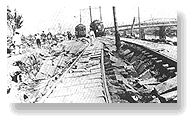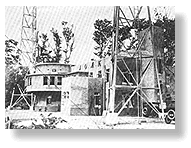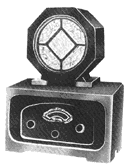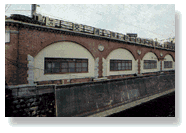Chapter 1-Early days- Akihabara before the war
The word “electrification” may not be appealing to young network workers. “Electrification”, or, in the present sense, just “electronicization”. It is a word that excites the hearts of Japanese people before and after the war, with the same sound as “informatization” today, or even more.
The room was dark until yesterday, and the lights came on. Events happened in the distance are conveyed by audio and video. You can drink cold drinks anytime. Freed from the heavy work of washing and cleaning. All of these were keywords that together with the word “electrification” make you feel a bright future.
Overview of Japanese history before the war

Japan, which has been trying hard to overtake and overtake the Meiji and Taisho eras and the West, has been booming and recessing like a roller coaster in tandem with global economic fluctuations and earthquakes.
During World War I, which began in 1914 (Taisho 3), the battlefield was in Europe, and during the war and during the reconstruction period, Japan was said to be unprecedented due to the export of military and civilian demand to Europe. did. However, as a result of that reaction, the stock price plunged in March 1920 (Taisho 9), followed by a long recession, and the Great Kanto Earthquake on September 1, 1923 (Taisho 12) devastated Tokyo and Yokohama. ..
The government carried out a 30-day moratorium (payment suspension), made the Bank of Japan special loan of 400 million yen for the earthquake disaster bill, and the government compensated loss of 100 million yen. By this measure, the economy was in a revival for a period of time, but it returned to the recession again due to the austerity policy of the Takaaki Kato Cabinet, which was established in 1924 (Taisho 13).
The Japanese economy was at the height of confusion due to overinvestment during the boom after World War I, the accumulation of bad stock, and the handling of bills after the earthquake.
On March 14, 1927, Naoharu Kataoka, who was then Minister of Finance in the Wakatsuki Cabinet at the House of Representatives, said that the Tokyo Watanabe Bank, which was still open, collapsed. Closed. It developed into installation noise, and the noise exploded and many small banks closed due to mounting noise even at the small and medium-sized banks in Tokyo and Yokohama.
Furthermore, at that time, Suzuki’s store, which had grown so rapidly that it threatened a chaebol-affiliated trading company, was suspended from the main bank, the Taiwan Bank. The turmoil of Suzuki Shoten, the largest debtor of the earthquake bill, shakes the entire Japanese economy as it is, and after the suspension of the Jyugo(15) Bank, one of the 5 largest banks at that time, it reached the top of the so-called “Financial Depression”. Reached
The government finally carried out a three-week moratorium and provided a special loan from the Bank of Japan to a government guarantee to calm the recession.
However, shortly after the sedation, the Japanese recession began in 1929 due to the effects of the Great Recession in the United States, and the 1930 (Showa 5) deflation and austerity policy due to the lifting of the gold ban on the Japanese economy. Established in response to the rise of the army and the imperial overseas invasion.
The Manchurian Incident of 1931 (Showa 6), the 5.15 Incident of 1932 (Showa 7), and the Japanese-Chinese Incident of 1937 (Showa 12) will lead to a time of tenseness.
The history of electrification and the dawn of Akihabara
In 1878 (Meiji 11), at the celebration of the opening of the central station of the Tokyo Telegraph, an electric light called an arc lamp was lit for the first time with batteries. Only five years later, in 1883 (Meiji 16), the Tokyo Electric Light Company (now TEPCO) was established as early as possible, and in 1887 (Meiji 20) the first thermal power plant was installed in Kayabacho.
At that time, when trying to apply electricity to homes and factories, electrical work was required and an engineer had to install it. This work was initially undertaken by the electric light company, but as the amount of work increases, the workmen who used to work for the electric light company will now undertake the work independently.
Especially during the booming economy after the First World War, which was explained in the history above, the factory equipment around the metropolitan area expanded rapidly and the amount of electrical work increased sharply. “Electrical material wholesalers,” who sell the “electrical materials” necessary for this construction, the so-called “electrical materials,” will flourish throughout Tokyo. “Electrical material wholesalers” sold electric wires, switchboards, and switches necessary for construction.
 On the other hand, in 1925 (Taisho 14), NHK started radio broadcasting. Against the background of the uneasy world at that time, it will rapidly spread as a means of entertainment as a means of obtaining information.
On the other hand, in 1925 (Taisho 14), NHK started radio broadcasting. Against the background of the uneasy world at that time, it will rapidly spread as a means of entertainment as a means of obtaining information.Only four years later, the number of subscribers (requiring a subscription for radio at that time) exceeded 600,000, and seven years later in 1932 (Showa 7) exceeded 1.6 million.
 Radios at that time were rarely complete products like today, and were “assembled radios” made by assembling parts such as vacuum tubes, speakers, and transformers.
Radios at that time were rarely complete products like today, and were “assembled radios” made by assembling parts such as vacuum tubes, speakers, and transformers.In an era of social confusion due to the favorable sales of both construction parts for factories and homes and sales of radio parts for the general public, “electric material wholesalers” are steadily growing.
However, Akihabara cannot be said to be the center of the city, and Kanda, Ueno, and Asakusa were only in the stage of gradually growing into commercial areas as areas between downtown areas since the Meiji era.
As a townscape at that time, Akihabara has a “Shimotaya” atmosphere, where shops and residences coexist. The largest number is horseshoes. There were many antique shops and Azabu shops. At that time, the only modern building was the Isetan department store, which had already moved to Shinjuku. (You can still see the stone monument of “the birthplace of Isetan” next to the Japan Petroleum Gas Station next to the Yamagiwa Rebina.)
In 1933 (Showa 8), Hirose Shokai and Yamagiwa Denki Shokai, which are currently the center of Akihabara, opened a store in Sotokanda. Hirose Shokai has expanded its sales to retail stores nationwide as a specialist wholesaler of radio parts, and Yamagiwa Denki Shokai has sold the original radio set and expanded rapidly, giving a hint of the future development of Akihabara.

From Taisho to Showa, Sudacho is the center of the tram, and the first train station of the National Railway Chuo Line, Manseibashi Station (currently the Museum of Transportation), has the 4th largest number of passengers a day in Tokyo, with people getting on and off lively. .. In 1927 (Showa 2), the first subway opened in Tokyo from Asakusa to Ueno. After that, when it was extended and digged under the current Mansei Bridge to penetrate it, it became a big topic at that time that a train would pass under the river.
Then, in 1941 (Showa 16), entered the Pacific War. The factory will be converted into a munitions factory. It becomes difficult to obtain electric materials such as radio-related materials except for military servants, and the distribution of light bulbs will become a situation where business will not be carried out rapidly.
1945 (Showa 20) From March 9 to 10, Tokyo was almost destroyed by the Tokyo air raid, and the townscape of Akihabara was almost scorched.
From this burnt field, we will welcome new prosperity after the war.
References:
「History of Chiyoda City (published by Chiyoda City)」
「The Akihabara (Nikkei Sangyo Shimbun)」
「The history of Yamagiwa 60 years」
「LAOX 50 years history」
